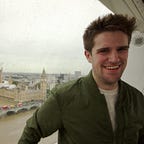Synthesis
Stephen Hillenburg’s Creative Journey to SpongeBob SquarePants
The story of how SpongeBob came to be in our world is a masterclass in the creative process. Stephen Hillenburg, the creator of SpongeBob, passed away this year, ending a one and a half year battle with ALS. He was responsible for the creation of a staple of American pop culture, news of his death has led to a torrent of memorialization across the internet, Facebook, Twitter, the Ringer, and even reddit’s /r/dankmemes, and rightfully so. The show’s combination of pace, absurdism, quips, and a borderline sing-songy vocal delivery style has etched a multitude of iconic moments into the brains of more than a generation of American children, creating a universal language of SpongeBob quotes and moments that form the basis of meme templates, friendships, communities and even romance.
It takes a village as diverse as Bikini Bottom to create genius that permeates pop culture in such a way as SpongeBob, and while Stephen created the world in which these characters lived and produced moments like “is mayonnaise an instrument?”, his writing staff and the genius cast of voice actors all have a share of responsibility for providing us with such a consistently joyous and relatable show. With that in mind, while reflecting on his passing, I wanted to seek out what about him specifically contributed most to the creation of the completely realized vision we now appreciate as SpongeBob SquarePants.
I gravitated towards an often-quoted part of the anecdote he shared while developing the characters that would eventually become SpongeBob, Patrick, and Squidward for his pitch to Nickelodeon. Stephen’s first love was cartooning and animation, but not seeing an avenue for it to turn into paying work, he began his career in marine biology, his second passion, at the Ocean County Marine Institute in southern California. Despite largely enjoying his life and career, even finding room on the job for his first love by creating an educational comic book about the animal life of tidal pools called The Intertidal Zone, when he saw an opportunity to enroll in CalArts’ Experimental Animation program under Jules Engel, he took it.
It was his time at CalArts that opened the door to his first professional animation job, a director on Nickelodeon’s Rocko’s Modern Life. While working on Rocko, one of the writers there, Martin Olson, read The Intertidal Zone and encouraged Hillenburg to create a television series with a similar concept. Stephen recalls later, “For all those years it seemed like I was doing these two totally separate things. I wondered what it all meant. I didn’t see a synthesis. It was great when it all came together. I felt relieved that I hadn’t wasted a lot of time doing something that I then abandoned to do something else.” It was his work from way back at the Ocean County Marine Institute, combined with the craft of animation which he honed for years, that came together to form the initial concept for what would become an American icon.
“It was great when it all came together. I felt relieved that I hadn’t wasted a lot of time doing something that I then abandoned to do something else.”
What Stephen achieved with this masterstroke of synthetic genius is something we could all learn from and seek to emulate in our own lives. He took inventory of what his passions and curiosities were and dedicated his life to them by mastering the technical craft of animation as well as professional expertise in marine biology. Perhaps most importantly, he remained aware of these passions enough to avoid ignorance to an opportunity to combine the two. He combined a passion project of his from his days as a marine biologist with a cartooning hobby to construct a world to play in for countless cartoon stories. And perhaps most importantly, when beginning to develop the characters and write what would become the pilot to pitch to Nickelodeon, he surrendered his ego and collaborated with his writing partners and voice actors to bring the characters we now know and love, to life.
It is stories like Stephen’s that give me confidence that world-changing opportunities will present themselves to us often, making our responsibility having the nose for these opportunities and the mastery to capitalize on them. While I am excited by the thought of what I can personally achieve with this mental model, it will be near impossible to match the positivity and scale of Stephen’s sponge who lives in a pineapple under the sea.
It is with deep appreciation that I offer my condolences to those who loved him most. Rest in peace, Stephen Hillenburg. Thank you for everything.
